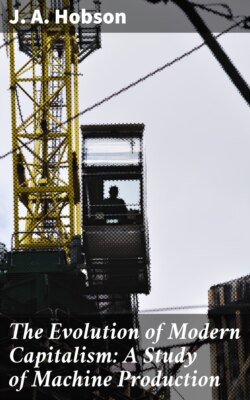Читать книгу The Evolution of Modern Capitalism: A Study of Machine Production - J. A. Hobson - Страница 16
На сайте Литреса книга снята с продажи.
Оглавление| Cotton Imported. lbs. | Inventions &c. | ||
| 1730 | 1,545,472 | 1730 | Wyatt's roller-spinning (patented 1738). |
| 1738 | Kay's fly-shuttle. | ||
| 1741 | 1,645,031 | 1748 | Paul's carding-machine (useless until improved by Lees, Arkwright, Wood, 1772–74). |
| 1764 | 3,870,392 | 1764 | Hargreave's spinning-jenny (patented 1770), for weft only. |
| 1764 | Calico-printing introduced into Lancashire. | ||
| 1768 | Arkwright perfects Wyatt's spinning-frame (patented 1769), liberating cotton from dependence on linen warp. | ||
| 1771 to 1775 | 4,764,589 | 1771 | Arkwright's mill built at Cromford. |
| 1775 | Arkwright takes patents for carding, drawing, roving, spinning. | ||
| 1779 | Crompton's mule completed (combining jenny and water-frame, producing finer and more even yarn). | ||
| 1781 | 5,198,775 | ||
| 1785 | 18,400,384 | 1785 | Cartwright's power-loom. Watt and Boulton's first engine for cotton-mills. |
| 1792 | 34,907,497 | 1792 | Whitney's saw-gin. |
| 1813 | 51,000,000 | 1813 | Horrocks' dressing-machine. |
| 1813 | 51,000,000 | 1813 | Horrocks' dressing-machine. |
| 1830 | 261,200,000 | 1830 | The "Throstle" (almost exclusively used in England for spinning warp). |
| 1832 | 287,800,000 | 1832 | Roberts' self-acting mule perfected. |
| 1841 | 489,900,000 | 1841 | Bullough's improved power-loom. Ring spinning (largely used in U.S.A., recently introduced into Lancashire). |
From this schedule it is evident that the history of this trade may be divided with tolerable accuracy into four periods.
(1) The preparatory period of experimental inventions of Wyatt, Paul, etc., to the year 1770.
(2) 1770 to 1792 (circa), the age of the great mechanical inventions.
(3) 1792 to 1830, the application of steam power to manufacture and improvements of the great inventions.
(4) 1830 onward, the effect of steam locomotion upon the industry (1830, the opening of the Liverpool and Manchester railway).
If we measure the operation of these several industrial forces within these several periods, as they are reflected on the growing size of the cotton industry, we shall realise the accumulative character of the great industrial movement, and form some approximately accurate conception of the relative importance of the development of mechanical inventions and of the new motor-power.
§ 7. The history of the cotton industry is in its main outlines also the history of other textile industries. We do not possess the same means of measuring statistically the growth of the woollen industries in the period of revolution; but since, on the one hand, many of the spinning and weaving inventions were speedily adapted into the woollen from the cotton industry, while the application of steam to manufacture and the effects of steam locomotion were shared by the older manufacture, the growth of the trade in the main conforms to the same divisions of time. The figures of imported wool are not so valuable a register as in the case of cotton, because no account is taken of home-produce, but the following statistics of foreign and colonial wool imported into England serve to throw light upon the growth of our woollen manufactures.
